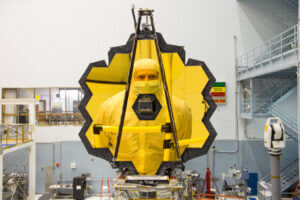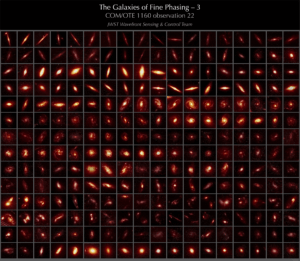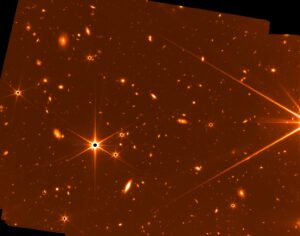
Though he had an idea what was coming, the first images from the James Webb Space Telescope left ACU physics alumnus Dr. Scott Acton (’84) speechless. He had spent “half a lifetime’s worth of effort” working on the mission, most recently as Webb’s wavefront sensing and controls scientist with Ball Aerospace.
In April, he was among the first to see test images sent back from the telescope after it had been fully aligned in space. For the test, Webb observed a small neighboring satellite galaxy called the Large Magellanic Cloud, revealing the galaxy’s dense field of hundreds of thousands of stars.
“These images have profoundly changed the way I see the universe,” he said at the time. “We are surrounded by a symphony of creation; there are galaxies everywhere!”
Now, the entire world is getting its first look at the capabilities of Webb through a series of stunning images released by NASA on July 12. As the largest and most complex space observatory ever built, Webb’s unprecedented sensitivity to infrared light will allow scientists to explore the early universe, the evolution of galaxies through time, the lifecycle of stars and other worlds outside our solar system.
In this Q&A, Acton discusses his time as a student at ACU, what it was like to work on a project with such far-reaching significance, and his favorite image captured by the telescope so far.
How did you become interested in physics?
One of my uncles, who has since passed away, was a Methodist minister. He was at my house in Riverton, Wyoming, and we were playing with a set of dominoes on the kitchen floor. We’d stack them up and knock them down. He asked me some interesting questions. He said, “What do you think would happen if we pushed these dominoes closer together? Would they fall down faster or slower? What would happen if we spread them further apart?” We did these experiments to see what was the fastest. Then he said three words that changed my life. He said, “That’s physics, Scott.” And I remember thinking, there’s a job where you get to do this kind of stuff all day long and you get paid for it? I lived in a tiny town in Wyoming, and I couldn’t see any further than the street I lived on. I had no vision, and just the tiniest little spark was ignited. From then on, when people asked me what I was going to do when I grew up, I said I’m going to study physics.
How did you come to attend ACU and what was your experience here?
I went to Central Wyoming College right out of high school and didn’t realize you couldn’t study physics there; you had to go to a university. Stanley Shipp (’46) [who earned his bachelor’s degree in chemistry from ACU and later became a legendary missionary] said, “Scott, I want you to go to Abilene Christian College.” I did a little checking around. It turned out ACC had become ACU, and they had a physics program. I was accepted within the week.
There I met [physics professors] Charles Ivey, Paul Morris, Mike Sadler – who has since passed away – and David Talent, who came later and was very important to me. These guys cared about me as a person. Even to this day, I’m still in touch. These guys believed in me. I wasn’t a very good student. You always talk about people graduating magna cum laude and summa cum l laude. I graduated “thank the laude.” I remember going through commencement ceremonies in 1984, sitting there and studying for a final exam in classical mechanics. If I didn’t pass that exam I wouldn’t get my degree. I went later and took that test and didn’t do very well, but Dr. Paul Schulze (’62) decided to pass me, and Mike Sadler gave me a recommendation for graduate school at Texas Tech University.
In talking about professors who made a difference in my life, I would have to add Dr. Henry Speck in the Bible department. I loved that guy. When I wasn’t doing well, he took me aside and gave me study tips. Just the way he could open and expose the Scripture to people in a lecture environment – it really had an impact on me. That’s when I realized the Bible really had something to offer.
I’ve really come to appreciate what those guys did for me as I’ve gotten older. I’ve come to realize there are many ways to make it in this world that are beyond getting a good grade in a class. What I’ve just now completed is a testament to that. I’ve gone literally as far as I can in my career in terms of the things I’ve tried to do. I’ve achieved international recognition due to sheer hard work and being given opportunities.
In layman’s terms, what was your role in the development of the JWST?

The complete non-scientist would understand when an image is out of focus. Many who talk about this, in particular Dr. John Mather, who’s the senior project scientist and won the Nobel Prize in physics back in 2006, he doesn’t even talk about wavefront sensing anymore. He just says “focusing” the telescope. That’s really what it is, except usually you adjust a single knob to focus something, and we have hundreds of knobs that all have to be focused on this telescope.
My job was to put together an algorithm, ground system and also people to align and phase the telescope after launch. We worked and worked and worked, and nobody thought it would take 24 years, which is how long I worked on it if you go all the way back. We officially ended it toward the end of May. It now not only has the wavefront sensing aspects, all the commissioning activities of the observatory have been completed, and it’s now considered an operational telescope. It’s no longer about making it work, it’s about keeping it working and using it for science.
What was it like to see these years of work come to fruition? Were there any tense moments after launch when you wondered if it would work as planned?
Well, I’ve never worked so hard in my life. My apartment door to the mission operation center [at NASA’s Space Telescope Science Institute in Baltimore, Maryland] was a 7-minute walk. I would continually be there in the control room and we would be looking at images or whatever, and I’d have a team of people looking at the computers. I’d say “OK, do this and do this,” and then I’d go home and sleep a few hours and come back and do it again. If anything important happened I wanted to be there.
There were a couple of moments when things happened differently than we had anticipated. We had commissioned the telescope a hundred times in software simulations, but there were some things wrong. First of all, we had a hard time pointing the telescope initially. We would say “Go to this part of the sky,” and it would try to go there but it would keep moving around a little bit. It took them a few weeks but they figured out what was wrong. We had to do some things very differently in the early steps of the commissioning process, and there were times when I had to do calculations by hand and say, “All right, these are the corrections we are going to apply to the telescope, and if I’m wrong we’re going to completely screw everything up.”
I was really getting really nervous about this. I was walking home one night talking to my wife on the phone and said, “Heidi, I’m really worried about this. What if I’m wrong?” And she said, “Scott, that’s why you’re there.” That was her way of telling me to “cowboy up.” The responsibility has to come down on somebody, and it was me in that moment. As it turns out I was not wrong. The commands to bring the telescope past these early steps of alignment were right.
What were your thoughts upon seeing the first images from the telescope?
Everyone gathered around this big conference room. People like the deputy associate administrator of NASA was there, the project scientist was there, all the smart people. My wife happened to be there. And finally when the first image came down, we could see it had 250 galaxies in it. One of our guys went through and extracted all the galaxies and organized them according to their type and made a nice poster-size image that had all those galaxies. One of them has a supernova in it. It was incredible. On the way home, I tweeted to a friend, “We are surrounded by a symphony of creation. There are galaxies everywhere.” A couple of weeks later, NASA asked me for a quote, and I thought, “Oh, what am I going to say?” Then I remembered this tweet. I hit copy and paste and sent it to them and it went viral.
Out of all these amazing images, do you have a favorite?

Yes, I do. It’s an image that was taken on our guidance system cameras, not the science instrument. The last thing we did was something called a thermal stability test. We just pointed the observatory at a single part of the sky and took our wavefront sensing images every few hours so we could monitor the stability. You are looking at this same point and you’re guiding on a single star. The way the fine guidance sensor works is that the star will always stay in the same place within that instrument, but how do you know the whole spacecraft isn’t rolling or turning? So someone says, “I know what we’ll do, we’ll guide on the first guider and we’ll take images on the second guider. We’ll take 20-minute images and if there’s any rolling or smearing, we’ll see it in those images.” So we did that. There are no filters, so every photon it can detect is put into that image. It’s a six-and-a-half meter telescope in the darkest place we’ve ever been, and it’s cryogenic, so there’s no thermal light from the telescope, either. Just one of those images is going to be impressive, but we took 90 of them and added them all together, and that became the deepest image of the universe ever taken. I sent that to an astronomer at UCLA, and he said he could estimate that single image contained 15,000 galaxies. Most of those galaxies are further than 13 billion light years away. Every one of those galaxies probably has between 100 and 200 billion stars. That’s my favorite image.
Why is the JWST significant? How is it different from the Hubble?
This is an infrared telescope, and that’s a main difference from the Hubble. It’s in deep space so there’s no light pollution from the earth or from the moon or from anything. And it’s extremely cold. The telescope is passively cooled; it gets cold because we keep the sun away from it with enormous sun shields. Anything that has a temperature – your body, anything that’s warm – emits infrared light. If the telescope were warm, we would be overwhelmed by just the light from the telescope. It would be hard to see the background. But since it’s cold, it doesn’t have any of that. The reason the infrared light is so important is two-fold: First of all, there are dust particles that will absorb visible light. So the Webb telescope allows you to see parts of the universe that wouldn’t otherwise be available to you. Second, the distant things are all moving away from us because the universe is expanding. All the light, because it’s moving away from us, gets shifted into the infrared. That’s why we can see these galaxies now; they’re all in the infrared because they’re moving away so fast. What limits how far we can see in the universe, even theoretically, is that at some point they are moving away from us faster than the speed of light.
What was it like working on a project that is so far-reaching in potential scientific discovery?
I’ve always felt that the challenge in any career is to balance finding meaning in the actual hours and minutes you spent working with finding meaning in the years. It’s possible to go to work and enjoy what you do. But I think there’s another element where you ask yourself, “Am I an appropriate steward with the years I’ve been given. Am I doing something that matters? Something that’s significant? Maybe to myself or maybe to God or maybe to the world?” It’s possible to enjoy your occupation but not feel any sense of accomplishment. And it’s possible to go to work every day and just hate it while recognizing that what you’ve done is extremely important. I feel like the James Webb Space Telescope enabled me to check both of those boxes. It’s really fun to be part of the scientific discovery, but also to know that there are kids out there who are going to look at the universe and think of it differently, be excited about it. Maybe the universe doesn’t care whether or not we’re looking at it, but I care.
Were there any especially memorable moments in the process?
A little bit before we got to the actual phasing of the telescope, we all had our moment where we realized the impact of what we were doing. And mine was this: To understand it, I have to tell you a little bit about how the spacecraft works. It will take an image and this stays in a buffer, and when the next image is taken it gets moved out of that buffer and put into memory. And when you have the opportunity, you download all that memory. Sometimes that last image is stuck in the buffer, and you can’t analyze everything until you get all your images. What we’ll do is insert a complete throwaway image into the process so it will flush out the buffer, and you get the last image you need. We took a 40-second integration on one of the fine guidance sensors, which are cameras used to help point the telescope but without special color filters. Eventually we received that throwaway image, too. When I could stretch the contrast on that thing, I realized there are probably more than 500 galaxies in that image. And we weren’t pointed anywhere in particular, we were just pointed randomly at the sky. I suppose there are some astronomers who realize it should be that way, even though we’ve never seen it. But for me, to know that all those galaxies are out there – I remembered a Scripture where it talks about the stars singing. So I pictured these galaxies singing, maybe not in any words humans could understand, but the emotion we can definitely understand, and that emotion is joy. In my mind I pictured that God was expressing joy that humankind, after all this time, could finally see the universe. Later I said, “We’re surrounded by a symphony of creation.”
Tell us about your family.
My wife, Heidi (Neiderheiser ’84), went to ACU. My son, John, just graduated magna cum laude from Harvard Law School. My daughter, Stacy Gasvoda (’15), has two children and is working on getting a master’s degree in speech pathology. She went to ACU for her undergraduate degree. So did her husband, David (’14), who is a lawyer, and they live in Kansas City. I also have a very famous uncle who is a former NASA astronaut, Dr. Loren Acton. He studied physics and eventually was the first person to study a field known as astrogeophysics, which has to do with the sun’s effect on the upper atmosphere of the Earth. He was a payload specialist on the Spacelab 2 mission in 1985. It was an interesting mission because they lost an engine while they were getting into space. It was a really close call there for a bit, but it all worked out. It was quite an experience for him and turned him into an environmentalist. If you could see the Earth out there, this thin little blue line, and everything that means anything to everybody exists in that tiny little blue line – you realize everything you care about is there.
– Robin Saylor
July 28, 2022
Learn more about ACU’s Department of Engineering and Physics
